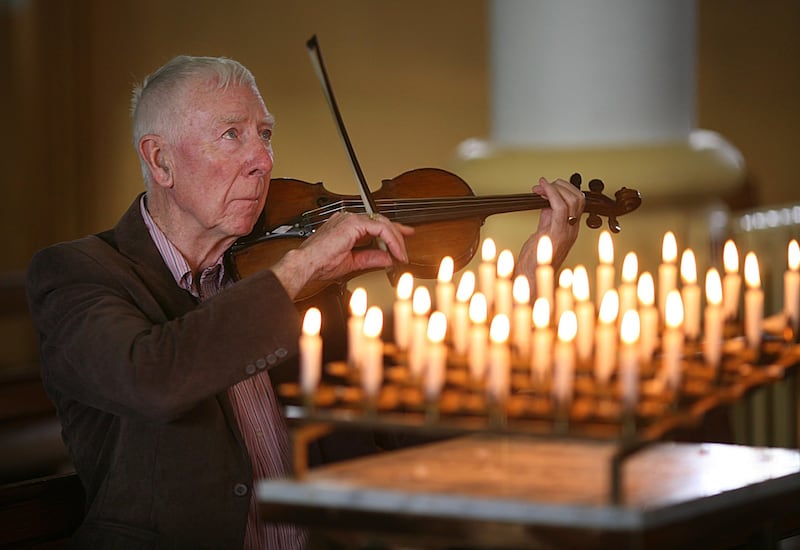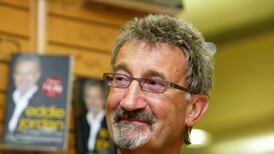Born: July 24th 1938
Died: June 8th 2024
For a musician whose tunes are now embedded in the fabric of Irish traditional music, Charlie Lennon made no secret of the fact that he was still learning about music well into his ninth decade.
This fiddle player, pianist and prolific composer died just a month before his 86th birthday and just a few nights after a memorable concert performance by fiddle player Martin Hayes in Lennon’s Stiúideo Cuan in his adopted home place of Spiddal. Hayes paid tribute to Lennon’s remarkable compositional talents by playing one of his early tunes, The Road to Cashel.
Lennon was the youngest son in a family of four boys born to Sally (née McGriskin) and Jim Lennon, both from Kiltyclogher in north Leitrim, near the Fermanagh border. His three older brothers were Ben, Joe and Alphonsus (known as Al), all of whom predeceased him. Like Charlie, Ben Lennon was a renowned fiddle player and fiddle teacher who was known for his rich repertoire of tunes.
Ben, Charlie’s older brother by 10 years, was a major early influence, and the pair were fascinated by the revered fiddle-playing emigrants to the United States, Michael Coleman, James Morrison and Paddy Killoran.

Lennon’s mother was a pianist, and once the young Charlie showed an interest in music, and in Ben’s fiddle in particular, she steered her youngest son towards the piano. He studied classical piano and diligently completed his classical grade examinations but he couldn’t resist his first love, the fiddle, even though he admitted that he struggled for some time with phrasing on the fiddle, a talent that came easily to him on the piano. As his fiddle playing evolved, it was influenced by the nuances and subtleties of Ben’s bowing, and was imbued with a lift, bounce and rhythm that was instantly recognisable.
Lennon left school at 10 and he devoted most of his energy to the fiddle, inspired by his early encounter with Fermanagh fiddle player, John Gordon. By the time he was a young teen, he embarked on a professional career as a musician, touring with bands across Ireland, Scotland and England, playing a wide mix of styles including English and Scottish country music.
Notwithstanding his evident musical prowess, Lennon was later persuaded by his brothers to return to education, and he completed his O and A levels by correspondence course, which led to his pursuit of a degree in Mathematics in the University of Liverpool at the age of 22. He excelled academically and went on to receive his PhD in nuclear physics in 1969. As recently as 2023, Lennon spoke of his satisfaction at seeing significant progress in nuclear fusion research in recent years, which bore a relationship to his own research some six decades earlier.
Lennon met his wife, Spiddal native, teacher and singer Síle Tim Ní Fhlaithearta at the Clones Fleadh. The couple spent the early years of their marriage in Liverpool, returning to live in Dublin in 1969 where he got a job with Aer Lingus. While in England, he played extensively with the Liverpool Céilí Band, and as he subsequently forged a highly successful career as a professional software and management consultant, he somehow managed to pursue a parallel life as a prolific performer, recording artist and composer.
Lennon recorded more than 50 albums in his lifetime, both as a fiddle player and as a piano accompanist. He was first recorded by Ciarán MacMathúna in 1957. Listening to his later recordings, it was evident that he set the bar for accompaniment, reshaping the role so that it did not fall into the realm of duet playing but instead offered a subtle and sensitive support to the soloist.
Lennon played regularly with Matt Molloy, Mick O’Connor, Johnny Connolly, Joe Burke and many others, and his tunes were sought out by musicians such as Frankie Gavin when they were planning sets for album recordings.
In the 1980s, he began to compose orchestral works, leading in 1991 to the performance of Bainis Oileáin/Island Wedding, by the RTÉ Concert Orchestra, conducted by Proinsias Ó Duinn. Later orchestral works included The Famine Suite, commemorating the 150th anniversary of the famine, and Áille na hÁille, commissioned by Gael Linn to commemorate the 1916 Rising. His Seeking Sanctuary suite followed in 2018. He was awarded the TG4 Gradam Ceoil for Composer of the Year in 2006.
The opening of Lennon’s studio in Spiddal in 1999 was another landmark, one which was imaginatively reinvigorated in 2021 when it was re-opened as Stiúideo Cuan: a major music and arts venue in Connemara, managed by his daughter Eilís in her role as executive director.
Liam O’Connor, director of the Irish Traditional Music Archive noted that “his exceptional talent as a composer meant he could forge new melodies that were instantly embraced by the traditional arts community and entered the living tradition. As an excellent fiddle player, whose skills as an accompanist set a new standard for the piano players, and as a composer, Charlie leaves behind a substantial body of new music and recordings that will have an enduring influence on traditional music for generations.”
O’Connor added: “As an accompanist on piano, he developed a whole new approach and standard to supporting the melody player, combining his deep understanding of the melody with a wonderful harmonic awareness.”
Few Irish composers have been as influential as Charlie Lennon on the repertoire played by traditional musicians. From Bantry to Boston, Charlie Lennon’s tunes can be heard occupying a central role in most sessions, alongside those composed by historic giants of the tradition such as the 18th-century composer Turlough O’Carolan or the great Paddy Fahey and Ed Reavy, a remarkable achievement within his own lifetime.
Lennon was a humble man, deeply reflective and open to new ways of looking at things. He encouraged his children to explore, without passing judgement. At the time of his passing, he was due to go into the studio to record some of his most recent compositions, having undertaken an in-depth study of the modal system in Irish music.
It is a mark of his standing as both a musician and composer, working as comfortably at the heart of the tradition and in that liminal space where traditional and classical idioms intersect, that a conference took place last October to honour his extraordinary contribution. This was the brainchild of Oisín Mac Diarmada and Tristan Rostenstock of TradTalk and took place at Stiúideo Cuan, where a concert featured a raft of musicians playing a selection of his many works.
It is puzzling how exceptional composers of traditional music like Charlie Lennon, who have left an indelible mark on the living art of our traditional music canon, are not considered for recognition by Aosdána. Such accolades did not however preoccupy Lennon himself, whose ears were forever cocked in anticipation of the arrival of another good tune.
Charlie Lennon is survived by his wife Síle, his sons Seán and Dónal, his daughter Eilís and by his seven grandchildren as well as his extended family. He was predeceased by his brothers Ben, Joe and Al.













